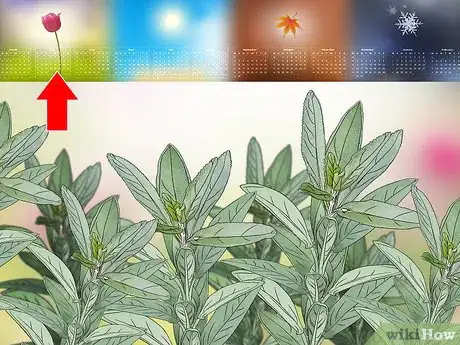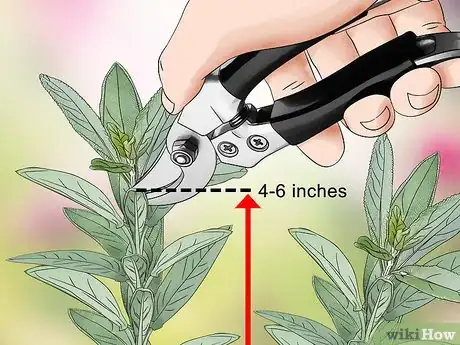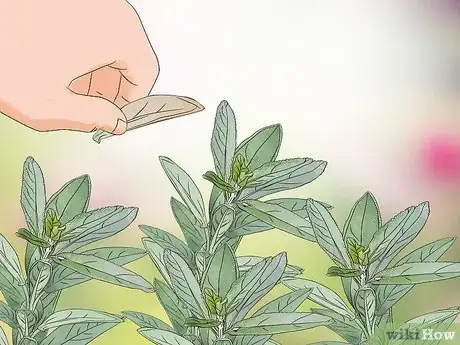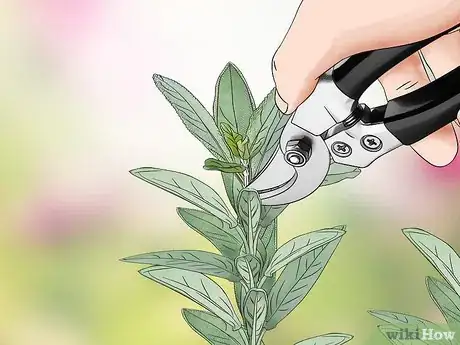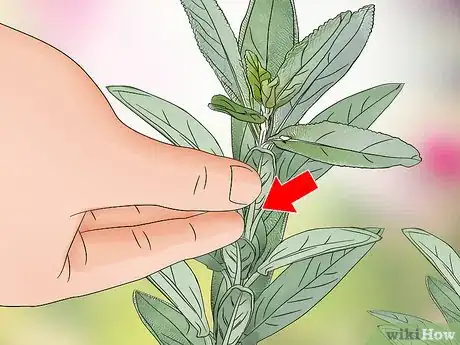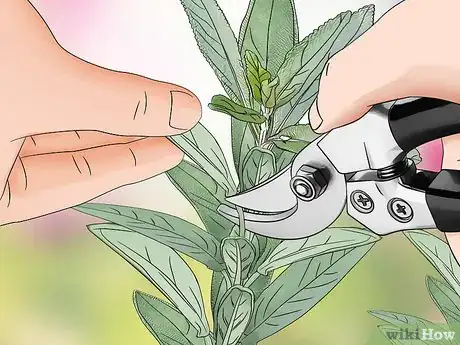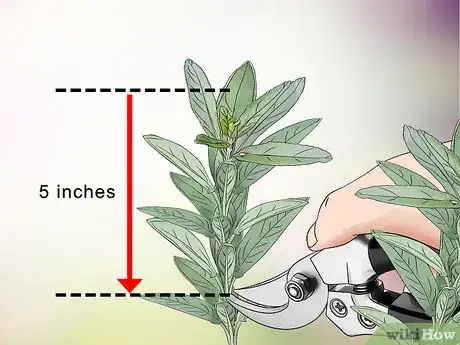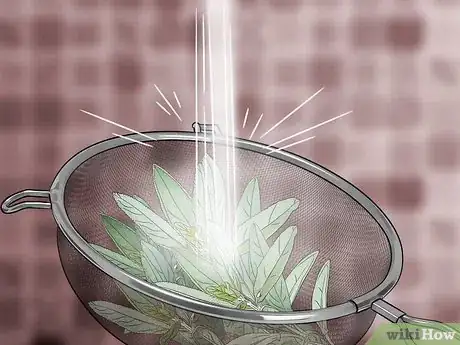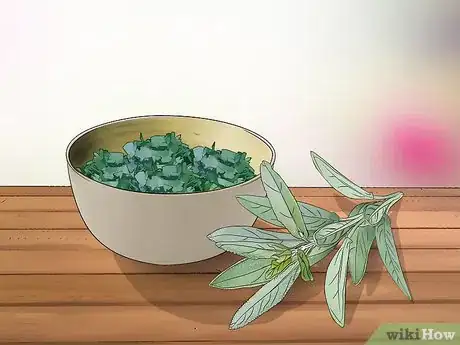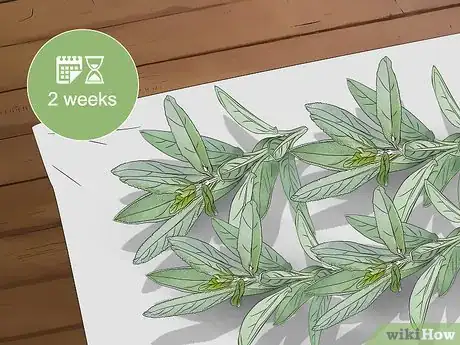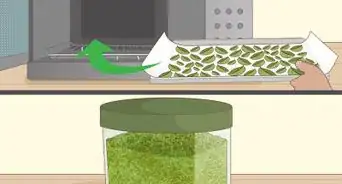This article was co-authored by Monique Capanelli. Monique Capanelli is a Plant Specialist and the Owner and Designer for Articulture Designs, an innovative design firm and boutique in Austin, Texas. With over 15 years of experience, Monique specializes in interior botanical design, living walls, event decor, and sustainable landscape design. She attended the University of Texas at Austin. Monique is a Certified Permaculture Designer. She provides plant and botanical design experiences, from small gifts to entire transformations, to shoppers as well as commercial clients including Whole Foods Market and The Four Seasons.
There are 9 references cited in this article, which can be found at the bottom of the page.
This article has been viewed 169,930 times.
Sage is a woody perennial herb that makes a great addition to both your garden and kitchen. Prune sage plants in the spring to ensure their healthy growth. Harvest sage leaves as you need them, or in bulk to dry and store for later use.
Steps
Trimming Sage Plants
-
1Prune sage in the springtime. It is not advisable to prune sage during the fall or winter. Pruning will make way for tender new growth that will be vulnerable to the cold and may be damaged or killed. Trim your sage plants in the springtime instead, just as new leaves begin to emerge.[1]
- Live woody stems can easily be mistaken for dead stems if they are pruned too early, so it is best to wait until some new growth emerges before starting.
-
2Cut stems so they are at least 4–6 inches (10–15 cm) from the ground. Use sharp scissors or garden shears to cut back the stems on your sage plant, just above new growth. Plants that are allowed to grow tall will likely fall over and their bottom leaves will be damaged. Make sure that there are still shoots on the remaining stems, and trim them less to ensure this if necessary. [2]
- Trim back half of the plant to ensure rejuvenation.
Advertisement -
3Remove spent leaves throughout the year. You can perform basic maintenance on your sage plants all year round by removing dead or dying leaves as you see them. Gently pinch and pull away leaves that are yellow in hue, shrunken, or dried up. If necessary, use scissors or pruners to cut the stems and remove dead leaves. [3]
-
4Prune your sage plant lightly during its first year to ensure that it grows fully. Young, growing sage plants can be vulnerable to damage if over-trimmed. During its first year, focus mostly on removing damaged or spent leaves. Be conservative about cutting away branches in the spring to ensure the plant's strength during colder seasons.[4]
Harvesting Sage Leaves
-
1Gently pull leaves off of the stem. It's generally recommended that you start your sage harvest in the morning. To do so, pinch the bottom of each sage leaf between your thumb and forefinger. Gently pull the leaf until it detaches from the stem. This should be a clean break that doesn't injure the stem.[5]
- Sage leaves can be harvested as you need them throughout the year.[6]
- Separate dry, dead, or yellow leaves from the healthy leaves you plan to keep.
-
2Use scissors or garden shears if you can't remove the leaves easily. Sage is a woody herb and its stems can sometimes be tough. If leaves can't be plucked easily from the plant, remove them using small, sharp scissors, herb scissors, or a pair of gardening shears. Cut the stems just below the leaves with clean, even cuts.[7]
- Be sure to use sharp scissor or pruners to avoid damaging or crushing the stems of the plant.
-
3Trim whole stems if you are harvesting larger amounts of sage. To harvest sage in bulk, it is more efficient to remove full stems with the leaves still attached. Cut stems about 3–5 inches (7.6–12.7 cm) below their tips. Grasp the stems with your thumb and forefinger and use sharp scissors or gardening shears to make each cut. [8]
- Remove any dead or damaged leaves that you see as you harvest the sage stems so that your kitchen herbs are as healthy as possible.
- You can store sage stems and pluck individual leaves as you need them.
- Sage stems can also be re-planted to propagate new growth.
-
4Rinse and dry off your sage leaves thoroughly before using them. Place your sage leaves in a colander and put it in the sink. Rinse the leaves thoroughly with cold water. Place them between two paper towels to dry them.[9]
-
5Use fresh sage leaves within a week of harvesting them. It is preferable to add freshly-picked sage leaves to your recipes right after you cut them. Sage adds great flavor to meats, stews and stuffing, and can be brewed to make medicinal tea. Dispose of sage leaves after a week if you have not used them. [10]
- Note that sage is a potent herb, so a small amount will add a lot of flavor to your dishes.
-
6Dry sage leaves for 2 weeks and store them in airtight containers. If you want to dry sage, hang up the stems or lay the leaves out on a paper towel to dry in a cool place with little humidity. Let them sit for 2-3 weeks. Once they are dry, place them in an airtight container and store them in a dark place out of the light.[11]
- Once your sage leaves are dried, they can be crushed easily with your hands if you wish to store them that way.
- Dried sage is stronger in flavor than fresh sage, so use it conservatively to avoid over-seasoning your meals.
Community Q&A
-
QuestionOne side of my sage is all wood. What happened?
 Community AnswerIt may need pruning so that sun reaches all branches, not just some. If it's container-grown, rotating it would make it look a little more uniform.
Community AnswerIt may need pruning so that sun reaches all branches, not just some. If it's container-grown, rotating it would make it look a little more uniform. -
QuestionShould I trim the flowers off of the sage?
 ChrisTop AnswererThere is no need to trim the flowers. You can continue to let them grow. Once the blooming season is over, however, you may want to cut the branches that flowered down, as they will be too woody for consumption. Trimming back the branches that flowered will also help promote new shoot growth.
ChrisTop AnswererThere is no need to trim the flowers. You can continue to let them grow. Once the blooming season is over, however, you may want to cut the branches that flowered down, as they will be too woody for consumption. Trimming back the branches that flowered will also help promote new shoot growth.
References
- ↑ https://www.finegardening.com/article/pruning-subshrubs
- ↑ Monique Capanelli. Plant Specialist. Expert Interview. 22 September 2020.
- ↑ https://www.finegardening.com/article/pruning-subshrubs
- ↑ https://www.almanac.com/plant/sage
- ↑ https://www.youtube.com/watch?v=Id8OjwsLPLM&feature=youtu.be&t=88
- ↑ https://www.thekitchn.com/everything-you-need-to-know-about-growing-sage-221035
- ↑ https://www.youtube.com/watch?v=rm24CgBeD1Q&feature=youtu.be&t=82
- ↑ https://www.youtube.com/watch?v=_Sx4X8yNt5w&feature=youtu.be&t=18
- ↑ https://www.youtube.com/watch?v=JEEBjxvxzIE&feature=youtu.be&t=54
About This Article
To prune sage, all you need to do is use clean, sharp gardening shears or scissors to cut the stems so that they are about 4 to 6 inches (10 to 15 cm) above the ground. This should be done in the springtime for best results. Remove dead or dying leaves, which you can identify by yellow coloring or dropping, throughout the year whenever you notice them. If this is the sage plant’s first trim, be very careful not to over-prune. Focus mostly on removing dead leaves instead of stem-cutting in order to encourage growth that will keep the plant healthy all year. To learn how to harvest your sage before pruning, keep reading!
